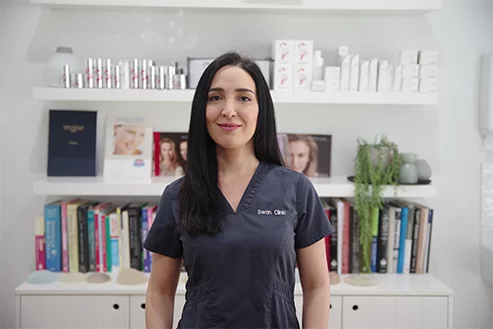BRACHIOPLASTY
Brachioplasty is a surgical procedure that addresses excess tissue in the upper arm, from your shoulder to your elbow.
Brachioplasty Techniques and Surgical Approach
- Traditional Brachioplasty
Traditional brachioplasty addresses excess skin and fat along the upper arms. The procedure involves an incision typically extending from the armpit to the elbow. Through this incision, the surgeon removes excess skin and, in some cases, fat. The remaining skin is repositioned and closed. - Mini Brachioplasty
This technique is suitable for patients with less extensive excess skin and fat. The incisions are smaller, often limited to the armpit area. Mini brachioplasty is recommended for those requiring less extensive treatment, which may also result in a shorter recovery period. - Liposuction-Assisted Brachioplasty
This approach combines traditional brachioplasty with liposuction. Liposuction is performed first to remove excess fat, followed by removal of excess skin through an incision similar to traditional brachioplasty. This combined method addresses both skin and fat in the upper arms. - Extended Brachioplasty
Extended brachioplasty is designed for patients with excess skin extending from the upper arms toward the lateral chest wall. The incision extends along the arm and onto the chest wall to allow for removal of a larger area of tissue. This technique is often used for patients who have experienced significant weight loss.
Surgical Technique
- Incision Placement: The location and length of incisions depend on the technique used and the extent of excess tissue. Incisions are strategically placed to reduce visible scarring while allowing effective treatment.
- Liposuction: For patients with excess fat but limited skin excess, liposuction may be performed alone or with brachioplasty. A small cannula is used to remove fat deposits.
- Tissue Removal: After incisions, excess skin and fat are carefully removed. The amount varies depending on individual needs. Attention is given to ensure smooth transitions between treated and untreated areas.
- Deep Tissue Support: In some cases, internal sutures are used to tighten underlying tissues for added support.
- Closure: Incisions are closed with sutures or staples aimed at promoting proper healing and minimizing scarring. Dissolvable sutures may be used to avoid removal later.
- Drains and Dressings: Depending on the procedure, drains may be placed to prevent fluid accumulation. Dressings and compression garments are applied to support healing and reduce swelling.
Potential Risks – Brachioplasty
As with any surgical procedure, brachioplasty involves general surgical risks as well as risks specific to brachioplasty surgery:
- Infection at the incision sites, which may require antibiotics or further treatment
- Bleeding or haematoma (collection of blood under the skin)
- Scarring, which may be visible and extend from the armpit to the elbow, depending on the technique used
- Delayed wound healing, particularly in areas with tension or movement
- Changes in sensation, such as numbness or tingling in the upper arm or forearm, which may be temporary or permanent
- Seroma formation (fluid accumulation), which may need to be drained
- Wound separation or breakdown, especially if there is excessive tension on the incision
- Asymmetry or uneven contour between arms after healing
- Persistent swelling, tightness, or discomfort in the upper arm
- Restricted range of motion in the shoulder or elbow during early recovery
- Anaesthesia-related risks, including allergic reactions or other complications during or after surgery
Recovery and Aftercare – Brachioplasty
- Swelling, bruising, and discomfort are common and generally improve within several weeks
- Pain relief may be prescribed or managed with over-the-counter medications, as advised by your surgeon
- Dressings and wound care instructions should be followed closely to reduce infection risk and support proper healing
- Compression garments or sleeves may be recommended to reduce swelling and support the surgical area
- Arm elevation and limited movement may be advised in the early recovery phase to reduce swelling and tension on incisions
- Strenuous activity, heavy lifting, or upper body exercise should generally be avoided for 4–6 weeks, or as directed
- Driving should only resume once you are off prescription pain medication and able to move your arms comfortably and safely
- Scarring may take several months to mature; scar care products or techniques may be discussed
- Smoking and alcohol should be avoided during recovery, as they can interfere with wound healing
- Final results may take a few months to stabilise as swelling subsides and tissues settle
- Follow-up appointments are essential to monitor progress, assess results, and address any concerns
If you have any questions or wish to discuss Brachioplasty options, please contact our clinic to schedule a consultation with Dr Reema Hadi.
For more information on Brachioplasty you can visit the Australian Society of Plastic Surgery

